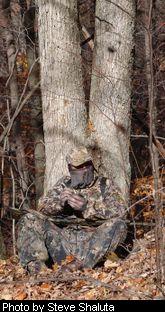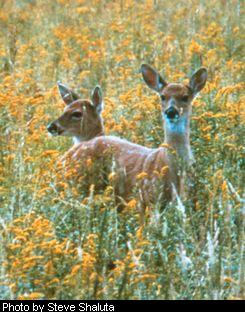

Reasons For The By Steve Wilson Have you ever wondered why a certain hunting season opens on a specific date or how season lengths or bag limits are set? Do you have an idea for a change in season dates or bag limits that you would like to suggest but don’t know the process? This article will explain the process for setting season dates and bag limits, tell you who actually makes these decisions, and discuss some of the factors that influence those decisions. Many people incorrectly believe that the Division of Natural Resources determines all hunting regulations. Season dates and bag limits are actually set by the Natural Resources Commission. The seven members of the Commission are appointed by the governor and serve staggered seven-year terms. The Commission is a key link in the regulations process, providing a balance between the biological needs of the resources and the desires of the public. Changes in season dates and/or bag limits recommended by the DNR are presented to the Commission in January each year. The proposals are also presented to the public through questionnaires and a series of public meetings in March. The Commission reviews the proposed changes and the public comments, and in late April or early May vote on the changes proposed for the current year. These changes, usually antlerless deer and bear seasons, must be made in time to print new hunting regulations brochures by July. Proposals scheduled to take effect the following year, are taken up at the July Commission meeting. All Commission meetings are open to the public and public comments are accepted at each meeting. The Commission may request the Wildlife Resources Section to evaluate proposals received from the public. Hunters, therefore, have significant opportunities to participate in the decision-making process. Regulations other than season dates and bag limits, such as hunting methods, and tagging and reporting requirements, go through a similar process. These types of regulations, however, must then go through the legislative rule making process and be approved by the state legislature. Regulation changes proposed by the DNR have been extensively reviewed before they are presented to the Commission and the public. Proposed changes may originate from recommendations by species or district biologists, wildlife managers, or hunters. Proposed changes are submitted in writing and include the proposed change, the expected impact on the resource, expected sociological and financial impacts, and the possible positive and negative effects on hunters. The proposals are distributed to game management biologists and then discussed at a meeting in January when harvest data for the previous year is available. A proposal may be rejected, approved or held for further study at this point. Approved proposals are forwarded to the Wildlife Resources Section Chief and then to the DNR Director for their approval before they are submitted to the Commission and the public. Regulation changes proposed by the DNR are primarily based on biological considerations. Clearly the first concern must be to maintain healthy, viable wildlife populations in balance with their habitat. Providing ample opportunity for public use of these resources, including hunting, is also a primary concern. Season dates and bag limits are used to regulate harvests so that game population levels may be increased, decreased or maintained at current levels. Sociological considerations such as hunter safety, the desires of hunters and even tradition also play a significant role in setting hunting regulations. Firearms deer seasons are a good example of a combination of biological and sociological factors. When deer numbers are low and the objective is to increase their numbers, biology dictates a season for bucks only after the breeding season. Because the Thanksgiving holiday would allow more people the opportunity to hunt and it is after the peak of breeding season, that week was chosen to open firearms deer hunting. As deer populations increased, biological considerations led to allowing limited antlerless deer hunting. Sociological considerations dictated a random drawing permit system to fairly allocate the limited opportunity. Deer populations are now above management plan goals in much of the state and both the season length and bag limits have increased. The tradition of not hunting antlerless deer prior to the buck season has been maintained. Bear seasons illustrate the dynamic nature of hunter preferences and tradition, as well as, their interaction with sound biological management. When bears were designated as game animals instead of varmints in 1969, the initial seasons were a week in early November and two weeks in December. This structure was based primarily on the desires of bear hunters to have both early and late hunting that did not directly conflict with other hunting seasons. Unfortunately, the bear population did not prosper under this season structure. The traditional approach to correcting this situation would have been to reduce or eliminate bear hunting, an option that many people favored. Fortunately, sound biology based on harvest data and radio telemetry studies provided a better solution. Sow bears, especially pregnant ones, nearly always enter their winter dens by late November. Instead of reducing the total season length, the days in November were shifted to December which provided protection for the female segment of the population without reducing hunting opportunity. The change was successful and bear numbers have increased significantly. In fact, bear numbers now exceed the sociological carrying capacity in some areas. Using the same biological information in 2002, the WRS recommended, and the Commission approved, adding hunting days in November in certain counties. The November season should result in an increased harvest of sow bears and a reduced population. The bear population is being closely monitored. After only two years, the bear population in one of the five counties in which a November season was added has decreased enough to close the season. The current fall turkey season is an example of compromise between biology and tradition. Fall turkey and squirrel seasons traditionally opened together in mid-October. Under that structure, the turkey population in counties with a fall season was growing at a much slower rate than counties without a fall season. Because the fall harvest is mainly hens and young birds, biologists believed a small reduction in the fall harvest would stimulate population growth. WRS biologists proposed a later opening date for fall turkey season to reduce the harvest. Hunters opposed the change and the Commission did not approve it. Biologists then recommended a compromise of moving squirrel season a week earlier but not changing the turkey season. This proposal had greater public support and was approved by the Commission. The change was successful in increasing the turkey population growth rate. With biological evidence in hand and increased public support the DNR then recommended, and the Commission approved, delaying the opening of turkey season by one week in 1995. The tradition of a split fall turkey season with one week in late December has fallen victim to expanding deer seasons. There are many more deer hunters than turkey hunters and having turkey and deer hunting seasons open concurrently could be detrimental to turkey populations. The need to increase antlerless deer hunting opportunity and the limited dates available resulted in the current four consecutive weeks of fall turkey hunting. Spring gobbler season is based entirely on biological consideration. Spring hunting went against tradition and the season was controversial when first initiated. But biologically it is the safest and most efficient season to harvest surplus male turkeys. The only function of the gobbler is to fertilize eggs and a single mating is all that is necessary, even if a hen must re-nest. The season opening date is based on the peak of the onset of incubation. This information was initially obtained by collecting the wingtips of young birds harvested in the fall season and determining hatch date by feather measurements. Telemetry studies of nesting hen turkeys confirmed that this date was accurate and applied throughout the state. Legal hunting hours end at 1 p.m. because incubating hens frequently leave their nest in the afternoon for food and water. The season takes advantage of reproductive behavior to make surplus gobblers easier to harvest. The date and hunting hours are set to provide the greatest possible protection for nesting hens. Advocates of an earlier opening date and/or all day hunting are often unaware of these important biological considerations. Bag limits are used both to regulate harvest and to help distribute the harvest among more hunters. Hunting has little impact on most small game populations such as squirrels or rabbits. Small game species typically have higher reproductive rates and their populations go up or down depending on habitat, food and weather conditions. Bag limits for these species allow more hunters to share in the harvest and discourage waste. Bag limits for big game species on the other hand are primarily designed to help regulate harvests. Deer bag limits vary considerably based on deer population levels
and management You now know who sets season dates and bag limits. I hope you have a better appreciation for all the biological and sociological factors that must be considered when establishing these rules. You can see from these examples that hunters, the DNR and the Commission all play important roles in setting season dates and bag limits that are biologically sound as well as acceptable to hunters. Steve Wilson is a wildlife biologist stationed in Elkins.
|

 objectives. Four southern counties have a maximum annual
bag limit of only two deer per hunter, while other counties with high
deer numbers have a maximum annual limit of nine. A hunter would have
to purchase all the available licenses and hunt the archery, bucks
only, antlerless and muzzleloader seasons to fill a nine- deer limit.
Only one of the nine would have to be an antlered buck but up to five
could be bucks. At least four must be antlerless deer and eight of
the nine could be antlerless. A purely biological approach would suggest
reducing the number of bucks allowed and requiring more antlerless
deer to be taken.
objectives. Four southern counties have a maximum annual
bag limit of only two deer per hunter, while other counties with high
deer numbers have a maximum annual limit of nine. A hunter would have
to purchase all the available licenses and hunt the archery, bucks
only, antlerless and muzzleloader seasons to fill a nine- deer limit.
Only one of the nine would have to be an antlered buck but up to five
could be bucks. At least four must be antlerless deer and eight of
the nine could be antlerless. A purely biological approach would suggest
reducing the number of bucks allowed and requiring more antlerless
deer to be taken.